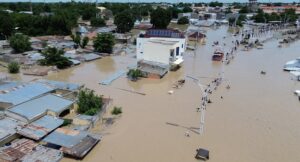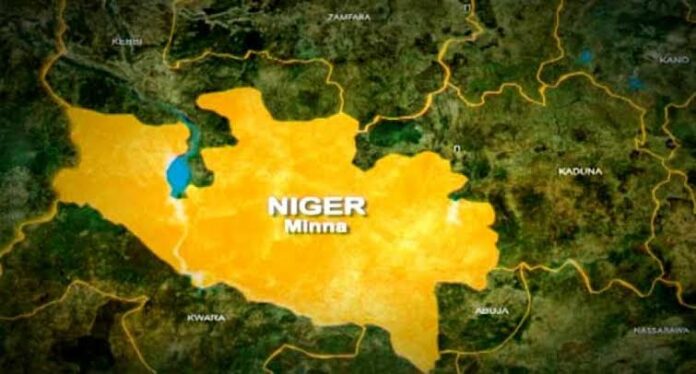In Niger State, a heart-wrenching tragedy has unfolded as devastating floods have claimed the lives of 11 people and left a trail of destruction across 19 out of the state’s 25 local government areas. The scale of the disaster is staggering, as entire communities struggle to cope with the aftermath. Families have been displaced, and livelihoods shattered as homes, farmlands, schools, and essential infrastructure are swept away by the raging floodwaters.
A shocking 118,692 farmlands have been submerged or completely destroyed by the floods, leaving thousands of farmers without their primary source of income. This loss is particularly devastating because agriculture forms the backbone of Niger State’s economy, providing sustenance and employment to a significant portion of the population. With these farmlands gone, many are now staring down an uncertain future, unsure of how to provide for their families. The economic toll of such destruction will be felt for a long time, as recovering from such a significant loss will take years.
Beyond the destruction of farmlands, the floods have wreaked havoc on education in the state, affecting 246 schools and impacting students in 529 communities. School buildings have been damaged, making them uninhabitable, and in many areas, access to these schools has been cut off due to washed-out roads. The disruption in education is another blow to families already reeling from the loss of their homes and livelihoods. The long-term effects of this on the region’s future cannot be overstated, as thousands of children will face delays in their education, potentially missing out on an entire school term or more.
 The extent of the devastation becomes even clearer when looking at the larger picture. According to reports, 34 communities have been severely impacted by the floods, leaving 41,192 people in desperate need of support. Many of these communities are in rural areas, where access to basic necessities such as food, clean water, and medical supplies was already limited before the floods hit. Now, these vulnerable populations are facing an even more precarious situation, with their immediate survival depending on the speed and efficiency of relief efforts.
The extent of the devastation becomes even clearer when looking at the larger picture. According to reports, 34 communities have been severely impacted by the floods, leaving 41,192 people in desperate need of support. Many of these communities are in rural areas, where access to basic necessities such as food, clean water, and medical supplies was already limited before the floods hit. Now, these vulnerable populations are facing an even more precarious situation, with their immediate survival depending on the speed and efficiency of relief efforts.
The local government areas hardest hit by the disaster include Mokwa, Katcha, Lavun, Lapai, Agaie, Shiroro, Munya, Gbako, Kontagora, Bosso, Edati, Agwara, Bida, Magama, Mashegu, Borgu, Gurara, Suleja, and Rijau. In these areas, homes have been washed away, roads have been destroyed, and bridges collapsed, making it even harder for rescue teams and aid workers to reach those in need. The destruction of 18 bridges and 80 culverts across the state has worsened the already dire transportation challenges. This has not only hindered relief efforts but also left many communities isolated, with no access to help.
Niger State Emergency Management Agency (NSEMA) Director General, Abdullahi Baba-Arah, confirmed the enormity of the situation, stating that over 6,865 households have been affected. He called on both state and federal authorities, as well as humanitarian organizations, to scale up their response to the disaster. The agency has been working tirelessly to provide immediate relief, but the scale of the crisis is overwhelming.
This disaster did not come without warning. Earlier this year, on April 17, the federal government issued a cautionary alert, warning that 148 local government areas across 31 states, including Niger, were at high risk of severe flooding between April and November. These warnings highlighted the urgency for preventive measures, but despite efforts to mitigate the damage, the floods have proven to be more destructive than anticipated.
As the floodwaters begin to recede, the full extent of the damage is becoming clearer. The rebuilding process will be long and arduous, requiring not only immediate relief but also sustained efforts to restore the communities and infrastructure that have been lost. The people of Niger State now face the difficult task of rebuilding their lives, homes, and livelihoods in the face of immense hardship.
What’s urgently needed now is a coordinated and swift response from both government and non-governmental organizations to provide the necessary resources for recovery. Immediate priorities include food, shelter, clean water, and medical aid, but in the long term, attention must be given to rebuilding schools, homes, and farmlands to help the affected communities regain their footing.
The Niger State government, along with its emergency management agencies, must also address the underlying issues that have made the region vulnerable to such disasters. Improved flood control systems, better infrastructure, and more robust early-warning mechanisms can help reduce the impact of future floods. Furthermore, there is a critical need for national and state governments to invest in climate-resilient infrastructure, as extreme weather events are expected to become more frequent due to climate change.
In the meantime, the affected families are relying on the goodwill of the public, humanitarian organizations, and the government to help them navigate through this difficult time. The resilience of the people will undoubtedly be tested, but with timely support, there is hope that they will be able to rebuild and recover.




